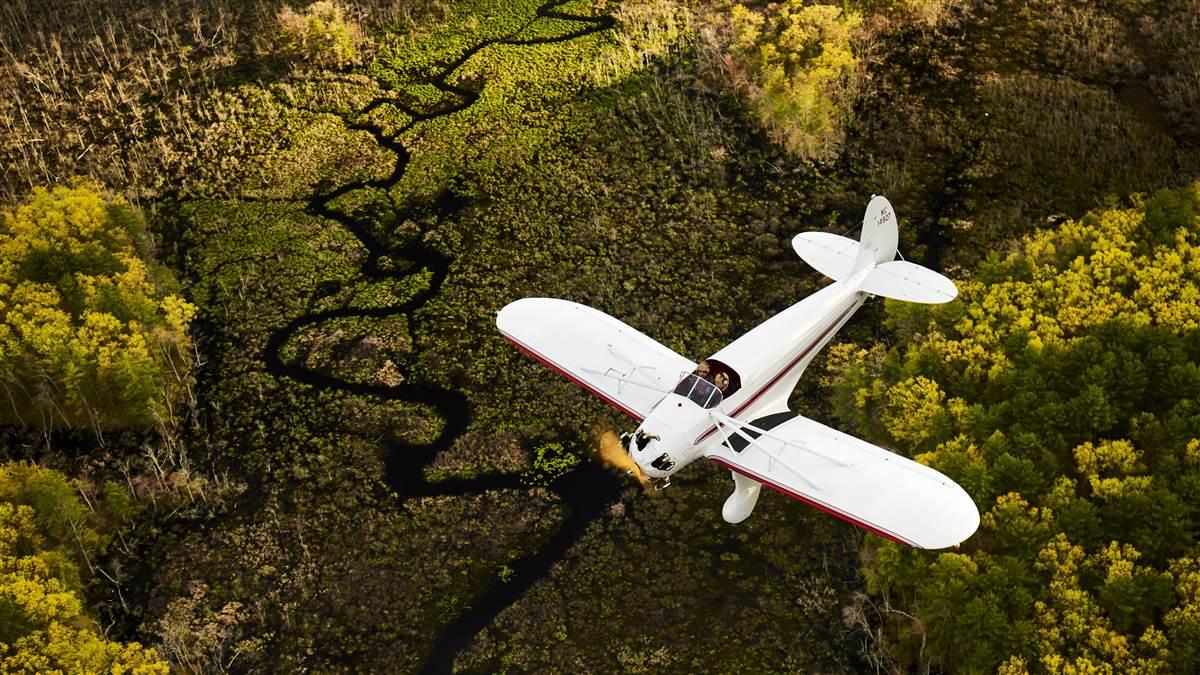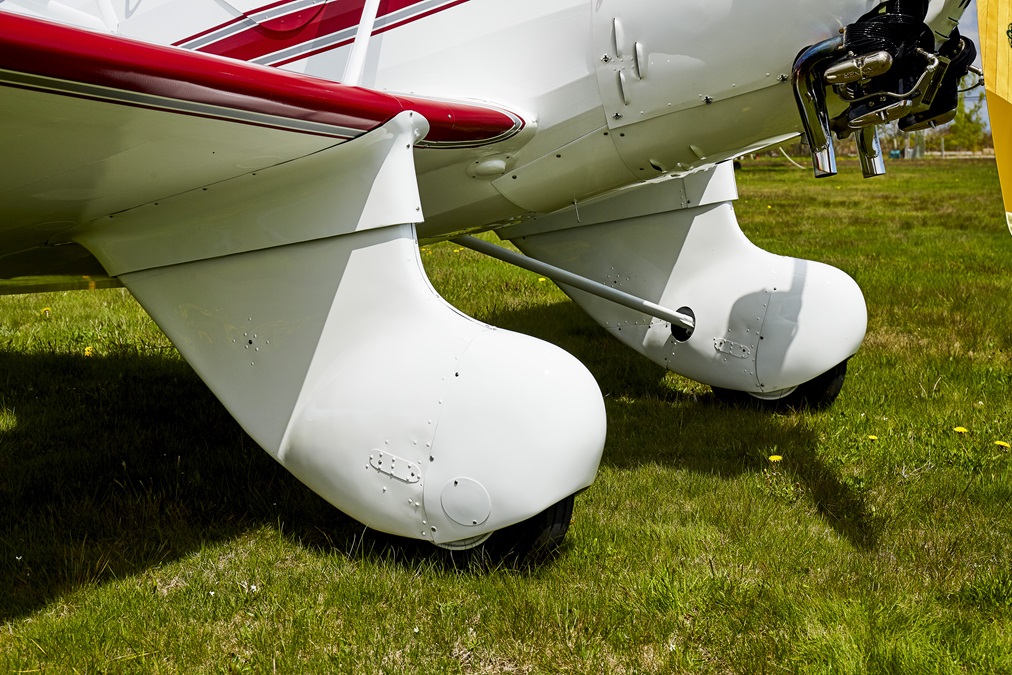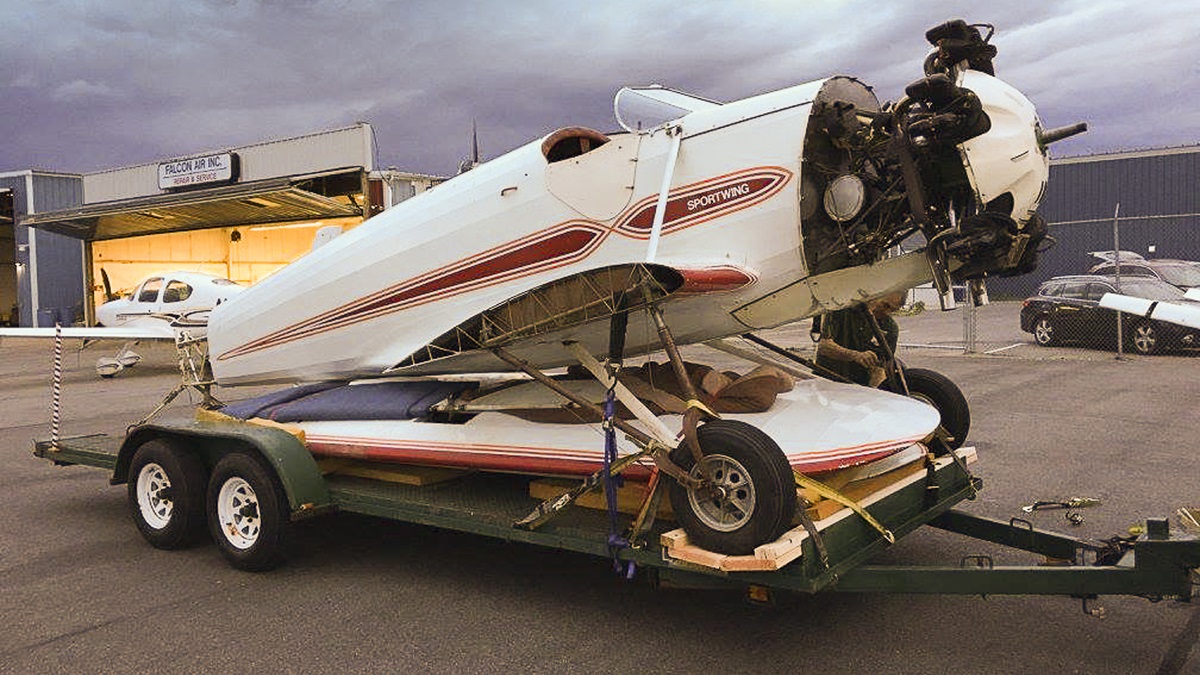Living history
The last Kinner Sportwing flies again

Barn airplanes
It would be an understatement to say Devries enjoys collecting and flying antique aircraft.
“My first classic aircraft was a 1940 Fairchild F24R, I sold that but now I have a 1938 Stinson and three airplanes from 1946: a Grumman Widgeon, a Globe/Temco Swift, and a Funk Model B,” he said. “I use a Bonanza for going places and a Super Cub on floats for commuting from my home, next to a lake in Windham, to the airport where I keep my planes, Lawrence Municipal outside Boston, just 8 miles away. And, of course, now the Sportwing.
“I’d seen the Sportwing years ago in Tulsa, Oklahoma, standing alone in a cold, dilapidated wooden hangar. It was absolutely beautiful, even covered with bird droppings and years of grime. It obviously hadn’t flown in some time. I was told it was the last one in existence and I never forgot it.”
More than 10 years later, Devries noticed a photo and listing for a Kinner Sportwing in Trade-A-Plane.
“The listing showed the owner was in Broken Arrow, Oklahoma, so I assumed it had to be the same plane. I contacted him and learned that he’d acquired it from another pilot, also from Broken Arrow, who had since passed away. The asking price for the plane was a considerable distance from what I was willing to pay, but I made an offer for what I thought the plane was worth, considering it hadn’t flown in many years. My offer was turned down and then the plane was off the market for a while.”
Restoring the Kinner Sportwing I






Finally, at the 2016 Sun ’n Fun Fly-In in Lakeland, Florida, Devries spotted the Sportwing on a trailer with a for sale sign.
“I was able to meet the owner in person and I made a new offer. He said many people were interested in the plane and he felt sure it would sell. I returned home to New Hampshire, thinking I’d never see the Sportwing again, when my phone rang. He had decided to accept my offer and we arranged for him to trailer the plane to my hangar in Lawrence.”
Golden Age of Flight
The aircraft Devries couldn’t forget was built during the Golden Age of flight, an era that is usually defined as the period of peace between the end of World War I in 1918 and the start of World War II in 1939. During that period, it seemed that every month an ever-more-daring flight was made, with pilots flying farther, faster, and higher; pilots such as Charles Lindbergh, Amelia Earhart, and Wiley Post became household names. Thrilling and dangerous air races were a popular public event, and youngsters across the nation followed the action through the new medium of radio. Pilots raced to win coveted trophies such as the Thompson Trophy, Bendix Trophy, and Pulitzer Trophy.
By the end of the 1930s, aircraft engineers threw wood and cloth biplanes on the junk heap and designed sleek, aerodynamically streamlined, highly polished metal monoplanes with ever-more-powerful engines. America was crazy for airplanes and everything about speed.
The Kinner Corp.
In the 1920s, the Kinner Airplane & Motor Corp. was founded in Glendale, California, by Bert Kinner. Max B. Harlow joined the company in the 1930s as chief designer, and he went on to design many of the Kinner aircraft, starting with the Kinner Sportster in 1932, the 1933 Sportwing and Playboy models, and the 1934 Envoy. The first airplane Amelia Earhart owned was a bright-yellow Kinner Airster she named the Canary.
By the 1930s, the Great Depression had set in. Kinner airplane sales were never strong, perhaps with fewer than 50 built and sold, and Kinner declared bankruptcy in 1937. The engine division was salvaged and reorganized as Kinner Motor Inc., and the new company grew to be the West Coast’s largest manufacturer of aircraft engines by 1941. However, it continued to struggle financially until its demise in 1946.
The 1935 Sportwing Devries purchased was an improved version of Kinner’s 1932 Sportster model. Jointly designed by Max B. Harlow and Robert Porter, the Sportwing features a two-place open cockpit with side-by-side seating, a tufted redleather interior, and doors that swing open much like roadsters of the period. The chrome door handles look like they came off an Auburn Speedster. The instrument panel sports a black crinkle finish with burnished aluminum control levers, in the style of the time. There are dual control sticks and throttles, so the airplane can be flown from either side.
Although all-metal aircraft were becoming common as the Golden Age progressed, this Sportwing is not all aluminum. It wasn’t built for speed records or racing, so the fuselage and wings are fabric-covered, with the engine cowling and landing gear fairings made of metal. The streamlined gear fairings and wheel pants, plus a louvered radial engine cowling, give it a Buck Rogers futuristic appearance.
Another feature reminiscent of 1930s’ automobiles is the sharply slanted, split windscreen, with stylishly curved side window panels, mounted in a brushed aluminum frame.
“For an open cockpit, there’s really no wind at all. The slipstream goes over your head,” said Devries. “Of course, if you stick your hand above the screen it’s in a 100- mile-per-hour breeze.”
Only eight of these stylish Sportwings were built, and unless one is hidden in a barn somewhere, Devries’s is the sole remaining example.
Restoring the Kinner Sportwing II




Restoration team
Devries said he acquired the Sportwing in April 2016 and took it to Posey Brothers Inc. for restoration in June. “Just over a year later, in August 2017, I got the call it was ready to fly again,” he said.
Mike and Larry Posey, along with Bill McDevitt—who specializes in fabric and wood repairs—have been restoring vintage aircraft for more than 40 years, primarily in eastern Pennsylvania and New Jersey. The team moved the Sportwing into a hangar at Van Sant Airport, in Erwinna, Pennsylvania, a grass airfield that attracts airplanes and pilots of a certain age.
“We were thrilled when we first saw it; it was pretty much all there and in good shape, except the wings,” said Mike. “It was 99-percent original, really with only a larger tailwheel than it should’ve had. We found and installed an appropriate wheel. The steel tube fuselage was in good shape, but we spent a lot of time varnishing the many wooden stringers and formers.”
McDevitt set to work on the wooden wing spars, which he said had a lot of rot. The Poseys sent the 5-cylinder radial engine out for overhaul to Bradley Ball of Antique Aero Engines in Santa Paula, California.
“If you want to overhaul your Kinner engine, Bradley’s the guy. He’s probably the only expert on Kinner engines in the country,” said Devries.
The Posey brothers are sticklers for authenticity when it comes to restoring historic aircraft, but Mike said owners often have their own ideas. Sometimes that means a compromise, such as the Sportwing’s paint scheme: The airplane was originally all white, but Devries wanted red and gray stripes. “It’s not accurate, but this design works; it looks like it should be there,” said Mike.
“The aircraft didn’t originally have an electrical system, and to fly these days in the Northeast, the owner really wanted a radio and transponder. So, we found a vintage wind-driven generator which we installed on the bottom of the fuselage. It’s from the same era, so you can’t really tell it’s not an original feature of the plane,” Mike said.
The Poseys installed a Trig radio and transponder, both which have remote controllers that fit in 2.25-inch holes in the panel and look acceptable next to the original 1930s instruments. The guts of the radio and transponder were hidden away under the panel, and a battery, charged by the wind-driven generator, was fitted inside the fuselage. A power outlet, for any portable electronic devices, was hidden behind a flap in the tufted red upholstery. Devries just peels it back if he needs to plug in a device.
The restoration was straightforward, but every project must have one item that just takes more effort than it should. In this Sportwing, that was the Eclipse Air Injection Starter. Since the Sportwing doesn’t have a typical battery and electric starter, an engine-driven compressor pressurizes an air tank to 450 psi, and this compressed air is used to start the engine for the next flight. Such a system—consisting of a compressor, copper tubing, valves, and an air tank—is likely to be balky, and this one certainly was. The Poseys found the original tank and tubing in good shape, but something, somewhere in the labyrinth of valves or the compressor was leaking air, so the system wouldn’t hold a charge. “If the plane sat overnight, it didn’t have enough pressure to start in the morning,” said Devries. The starter adamantly resisted all efforts to pinpoint its leak. So, Devries accepted the airplane with the leak and developed a work-around for the leaky air starter.
“I have a large air tank, connected to a compressor, in my hangar and I just charge the onboard air tank from it before starting. That works when I’m at home,” he said. “For those times when I’m away, I bought a small portable air tank and a hose that connects to the air starter. It weighs only about 15 pounds and fits in the luggage locker. So, when I fly somewhere and need to start, I plug it in and it spins right up. There’s always the option of hand propping it, too, which I don’t mind doing.”
After a year and a half of flying, Devries has identified the leaky valve, but “you can’t just call the shop and buy a new one. It’s 84-year-old equipment, so I’m looking around for someone who can custom make a new valve to match the old one, but maybe one designed to work better. For now, my portable air tank works so well, it’s not been a priority.”
First flight
After a year under the hands of these skilled craftsmen, the big day came at last. The then-82-year-old was ready for its latest “first flight.” On July 22, 2017, the Sportwing lifted off the grass at Van Sant under the confident control of Larry Posey. Mention Larry’s name around here and the same sentence is uttered by everyone: “Larry, he’s flown everything.”
A video of the first flight was sent to Devries, and he knew it would soon be his turn to fly this classic airplane. Three weeks later, on August 26, a small group of early-morning pilots gathered around the Van Sant hangar as the Sportwing was pushed out onto the dew-covered grass for Devries’s first flight. He’d flown in at dawn to take possession of the airplane he’d dreamed of for a decade. Although Devries has extensive experience flying vintage aircraft, he’d make his first flight with Larry Posey in the co-pilot’s seat, primarily to assist with the engine start and for advice on the eccentricities of this particular model. The engine was hand-propped for the first flight of the day, and after some taxi practice, Devries lifted from the grass for an introductory flight over the Pennsylvania countryside to get the feel of the Sportwing. After landing and topping off the tanks, Devries was ready to make the 225-mile flight home.
Likes to fly
“The most surprising thing is how the Sportwing jumps off the runway; it really likes to fly,” Devries said. “It prefers to go up rather than down, and you need to pull the power and put the nose down to get it to descend. It handles very well in the air with only light control inputs.
“I fly the pattern at about 80 mph and 70 mph over the numbers,” Devries continued. The Sportwing has no flaps, so proper application of forward slips are essential when landing in short fields.
The airplane’s wide wheelbase makes for docile landings. “The Johnson brake system is very different from anything I’ve used before and requires a little practice. To brake you pull out a T-handle mounted on the instrument panel, and that activates the brake system. Then, whichever rudder pedal you push is the brake. Push the right pedal to turn right or the left pedal to go left. The harder you pull on the handle the stronger the braking action.
“Flying an open cockpit airplane takes a little getting used to, but once you do it’s fantastic,” Devries added.
“The only problem was that the open cockpit is so bright I couldn’t read my GPS,” said Devries. After a few attempts to make visors out of black construction paper and black plastic, it became evident that no amount of shielding would allow the GPS screen to be easily viewed. A little online research uncovered another pilot with the same problem who solved it by taking a technological step backward. That pilot, and now Devries, found that the monochrome display GPS units are much more readable in the bright sunlight. So, Devries dug out his old Garmin 196, which features a 12-level grayscale LCD display with backlighting, and now he uses that for navigation.
“The Sportwing is not really my preferred cross-country airplane, so I’m usually just flying 50 miles or so to a fly-in,” said Devries. “The Garmin 196 is perfectly mission appropriate for that type of short flight.”
Saying goodbye
The Posey brothers were a bit nostalgic as the one and only Kinner Sportwing disappeared from view over the Pennsylvania countryside. “As the plane came together, and after we made the first flight, we were liking it more and more each day, but now it’s gone,” said Mike Posey.
Although the Sportwing has gone to a new home, there’s always a new bit of vintage aviation history to save for future generations.
Restoring the skinner sportwing III





